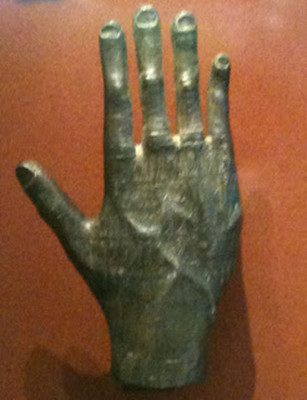It's a pretty baffling series of names and places.
這一大串人名和地名確實有點兒讓人頭暈。
But if you're a historian trying to reconstruct the society and the religion of ancient Yemen, pretty well all you have to go on is inscriptions like this one.
但歷史學家重建古代也門社會與宗教信仰的工作幾乎全部建立在這樣的銘文上,它們的信息量很大。
There are about 10,000 of them known, each one, it has to be said, more opaque than the other.
大約每個都有10000,不得不說,一個比另一個更晦澀難懂。
But if you actually unpick the inscription on this hand, it does in fact contain a great deal of information.
但是如果你真正破解出銘文后,它實際上包含大量的信息。
From it we learn that this bronze hand was dedicated at the temple of the god Ta'lab Riyam, in a place called Zafar, high in the Yemeni hills.
專家破譯出文字后,我們了解到,這只手曾被供奉在也門山丘高處一個叫薩法城的地方的塔拉布里陽神廟里。
The owner of the hand, Wahab Ta'lab, tells us that he belongs to a clan, and that that clan in turn is part of a larger tribal organisation, whose god was Ta'lab.
手的原主人瓦哈塔拉布來自某個部落,而這個部落屬于一個規(guī)模更大的、信奉塔拉布神的族群。
So, Wahab Ta'lab had obviously been named after his own god.
因此, 塔拉布的名字顯然來自他所敬拜的神祇。
And as a further sign of faith he's dedicated his hand publicly to Ta'lab, at the centre of the city of Zafar, where it would have been seen along with other offerings of gold, bronze or alabaster, representing human figures, animals, arrows, spear heads, that sort of thing.
為了表現虔誠,他將自己的手公開獻給薩法城中心的神廟,與人們獻上的其他供品擺在一起,其中包 括塑造成人、動物、弓、箭頭等形象的金、銅與雪花石奇制品。
But in return for these offerings, the god Ta'lab was expected, in general terms, to see the donors alright.
供奉者希望神能夠賜福他們作為回報。
But Wahab Ta'lab must have been pretty alright to start with, only a man of real wealth could offer a bronze hand as beautifully made as this.
但瓦哈塔拉布一定相當富有,只有富人才能供奉如此精美的青銅手。
But, by the international standards of the day, his whole society was wealthy.
不過按照當時的國際標準,他整個族群的成員都很富有。
At the time of our hand most of south Arabia was effectively one state-a confederation of tribes like Wahab Ta'lab's, known to historians as the Himyarite kingdom.
青銅手制作時期,幾乎整個阿拉伯半島南部都屬于一個國家,一個由類似塔拉布所屬族群所組成的城邦聯合體,歷史學家稱之為希米亞里特王國。












